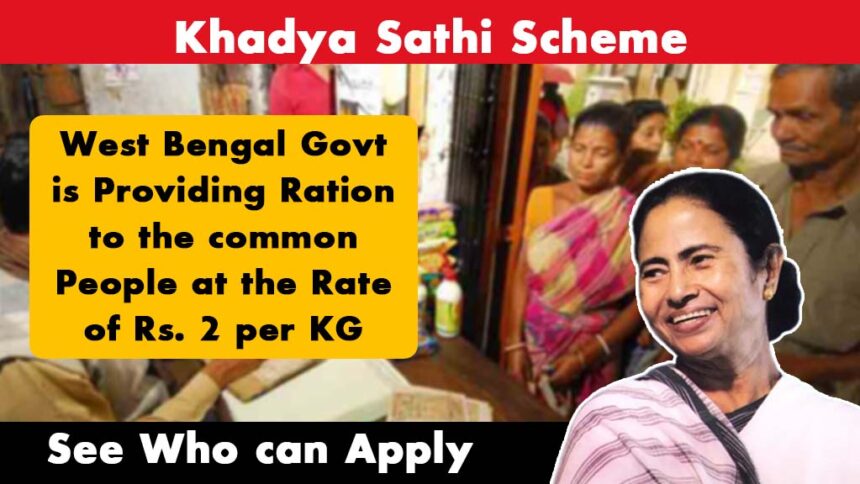Food is one of the most basic human necessities. Ensuring food security for every citizen is essential to uphold social equity and human dignity. In this context, the Government of West Bengal launched the “Khadya Sathi Scheme” with the aim of delivering essential food items at nominal prices or completely free of cost to the poor and marginalized sections of the state.
This initiative is more than just an economic relief program—it is a humanitarian mission through which millions of people are assured of their daily meals. The Khadya Sathi scheme represents a significant public welfare initiative, striving to ensure that no citizen of the state suffers from hunger due to poverty.
More than just filling empty stomachs, the scheme is a symbol of social justice, compassion, and government accountability. People can now live with peace of mind, free from the daily fear of food insecurity, thus laying the foundation for a healthy, stable, and dignified life. Notably, during the COVID-19 pandemic, this scheme played a critical role in providing free ration to millions, helping them survive during times of extreme uncertainty. The integration of digital systems into the program has also ushered in a new era of transparency and efficiency.
Overall, the Khadya Sathi Scheme is not just about food assistance but also a powerful tool to combat poverty, malnutrition, and social instability.
What is the Khadya Sathi Scheme?
The Khadya Sathi Scheme is a social welfare and humanitarian initiative by the Government of West Bengal. It ensures easy access to essential food grains for the general public, especially those belonging to the economically disadvantaged and socially marginalized communities.
The scheme was launched on January 27, 2016, under the leadership of Chief Minister Mamata Banerjee. Since then, the state government has been providing food security to a massive number of people. More than a ration program, it symbolizes the state’s commitment to upholding a basic human right—the right to food.
Under the Khadya Sathi scheme, lakhs of families receive monthly allocations of rice, wheat, and other food grains through ration cards from government-subsidized shops. The government offers heavy subsidies to ensure that food items are available at either very low prices or completely free for eligible citizens.
The significance of this scheme became even more evident during the COVID-19 crisis, when many people who lost their jobs relied entirely on government ration for survival.
In essence, the Khadya Sathi Scheme is a groundbreaking move toward ensuring food justice, reducing poverty, and promoting social well-being.
Primary Objectives of the Scheme:
- Ensuring social justice in food access
- Providing safe and secure food to the poor and marginalized
- Preventing hunger and malnutrition due to food scarcity
- Stabilizing the prices of essential food items
- Transforming the right to food into a practical reality
Eligibility to apply khadya Sathi scheme:
According to the Government of West Bengal, the following groups are eligible to benefit from the scheme:
- Extremely Poor Families: Those living in abject poverty with little or no income are the primary beneficiaries.
- Scheduled Castes (SC) and Scheduled Tribes (ST): Special provisions are made for these historically disadvantaged communities.
- Senior Citizens (60+): Elderly individuals without stable income or employment qualify for free or subsidized food.
- Persons with Disabilities: Individuals with physical or mental disabilities who cannot support themselves receive special support.
- Pregnant and Lactating Women: Nutritional support is provided to ensure health and well-being during and after pregnancy.
- Orphaned or Destitute Children: Children without guardians or living in extreme poverty are covered under the scheme.
- Daily Wage Laborers: Those without regular income, such as construction workers or casual laborers, are included.
- Farmers, Fishermen, and Agricultural Workers: Seasonal or irregular earners engaged in farming or fishing also receive ration at subsidized rates.
- Families Below the Poverty Line (BPL/NFSA): Those living below the income thresholds defined by the government qualify automatically.
- Elderly Women (Widows or Childless): Senior women living alone with no support are also given priority under the scheme.
Key Benefits Under the Khadya Sathi Scheme:
- Rice and Wheat at ₹5/kg: Eligible families can purchase essential grains at subsidized rates.
- 5 kg Food Grains Per Person Monthly: Every registered family member is entitled to receive 5 kg of food grains per month.
- Completely Free Ration: Certain categories, such as persons with disabilities, SC/ST members, and destitute individuals, receive their food entirely free of cost.
What is the Khadya Sathi Card?
To avail the benefits of the scheme, each beneficiary is issued a Khadya Sathi Card, which is digitally linked to their Aadhaar number. It functions similarly to a digital ration card and enables beneficiaries to collect their allotted rations from designated shops.
Required Documents
- Ration Card .
- Aadhaar Card .
- Voter ID Card .
- Proof of Address .
- Income Certificate .
- Passport-Size Photograph
- Birth Certificate
Online Application and Inclusion Process:
Keeping pace with technological advancements, the scheme now allows for online applications, reducing corruption and harassment. To apply, one needs:
- Aadhaar Card
- Voter ID / Birth Certificate
- Income Certificate
- Family details
Applicants must visit https://food.wb.gov.in and complete the application form. Once verified and approved, a Khadya Sathi Card is issued.
Digital Rationing and PDS Transformation
The government has modernized the Public Distribution System (PDS) by integrating it with digital platforms. Through ePOS (Electronic Point of Sale) machines, ration is distributed, ensuring presence verification and preventing fraud. This digitalization has made the system more transparent, accountable, and efficient.
How to Check Ration Card Application Status under Khadya Sathi Scheme
You can check the status of your ration card application online by following these steps:
Step-by-Step Process:
- Go to the official website of the West Bengal Food and Supplies Department:
https://food.wb.gov.in - On the homepage, click on “Ration Card Services” or look for “Check Application Status”.
- Select “Application Status of Ration Card” from the dropdown or menu.
- You will be asked to enter:
Your Mobile Number
Or your Application/Reference Number
- Enter the required details and click “Search” or “Check Status”.
- Your application status will be displayed on the screen.
Alternative Methods:
You can also visit your nearest Bangla Sahayata Kendra for help with checking the status.
If you applied offline, you may check the status at your local ration dealer or Food Inspector’s office.
How the Khadya Sathi Scheme Is Helping People:
- Impact During COVID-19:
The scheme saved millions of lives during the lockdown by providing free food grains to families who had lost their livelihoods. - Reducing Malnutrition:
The scheme is a blessing for many poor households struggling for two meals a day. It has helped reduce malnutrition, especially among children and the elderly. - Empowering Women:
With food security ensured, many women are now able to focus on their children’s education and family well-being.
Conclusion
The Khadya Sathi Scheme is undoubtedly a remarkable and compassionate initiative by the West Bengal Government that has ensured food security for millions. It is not just about feeding people—it is about restoring dignity, building self-confidence, and offering hope for a better future.
Other states across India can draw inspiration from this model to enhance their food security frameworks. The scheme is more than a government plan—it reflects a social responsibility where the state commits to fulfilling the basic right to food for every individual.
By making ration distribution digital, transparent, and efficient, the state has improved its public service delivery, reduced corruption, and strengthened accountability. Especially during times of disaster, such as the COVID-19 crisis, the scheme emerged as a beacon of hope.
If expanded and further digitized, the Khadya Sathi Scheme can become a robust model for eradicating poverty and ensuring sustainable development.











